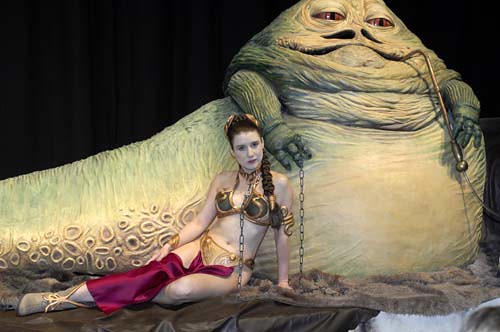1. With so many light saber duels, why is there so little blood? Even blasters kill without gore or carnage. In Section 14.11 of IPMB, Russ Hobbie and I discuss tissue ablation. According to Wookieepedia, ablation cauterizes wounds, preventing bleeding. This is the same reason we use lasers in surgery.
2. Why do blaster shots not propagate at the speed of light? Chapter 14 of IPMB gives the speed of light as 3 × 108 m/s. In Star Wars, shots travel not much faster than a hard-thrown fastball, maybe 100 m/s. Apparently this far-away galaxy has a large permeability of free space, μo. Next time you view these films, watch for exaggerated magnetic effects.
3. How did Han Solo freeze so quickly (and reversibly!) in carbonite? The bioheat equation developed in Chapter 14 of IPMB implies that heat diffuses into tissue, and over long distances diffusion is slow. My guess is that carbonite freezing makes use of the blood flow term in the bioheat equation, perhaps by rapidly injecting cold carbonite intravenously. However, I don’t see any IV tubes coming out of Han. Do you? Carbonite freezing has to be dangerous. But no matter; had Han died during freezing, Chewbacca would have saved Princess Leia.
4. How does Luke Skywalker’s artificial hand work? Chapter 7 of IPMB discusses electrical stimulation of nerves, which is crucial for developing neural prostheses. Luke had such a prosthesis after he lost his hand during his epic duel with Darth Vader (Luke’s FATHER!). Functional neural stimulation is becoming so sophisticated that artificial hands may arrive sooner than you think.
5. How does Darth Vader control his breathing? Chapter 10 in IPMB analyzes feedback loops, and our main example describes how we control the carbon dioxide in our blood by adjusting our ventilation rate. I wonder, does Vader’s mask break that feedback loop? Perhaps a carbon dioxide sensor in the mask adjusts the rate of his slow, heavy breathing. I suspect something is horribly wrong with his physiological control mechanism, because once the mask comes off Vader dies.
6. What determines the anatomy of all those alien life forms? In Chapter 2 of IPMB, Russ and I describe how size impacts the structure of animals: scaling. One famous result involves the strength of bones. Body mass scales as length cubed, but the strength of a bone scales as its radius squared, meaning that bones must get thicker relative to their length in larger animals. This is why Jabba the Hutt has no legs. Yoda lied when he said “size matters not.”
7. How did Luke avoid freezing to death on Hoth? When an animal dies, it loses heat according to Newton’s law of cooling (Chapter 3 in IPMB). After Han killed the tauntaun and shoved Luke into its belly, its temperature began to fall exponentially. Luke must have gotten really cold. What saved him was immersion into a bacta tank, which speeds rewarming by taking advantage of convection as well as conduction. I suspect bacta may also contain suspended stem cells, but who knows? Whatever the mechanism, Luke survived. During his recuperation is the most disturbing event in the entire Star Wars saga: the incestuous kiss. Ewwwwww!
8. What did leaders of the Rebel Alliance say when they realized that Vader knew about their plans to attack the Death Star? One way to measure radiation dose is to use thermoluminescent phosphors, which Russ and I describe in Chapter 16 of IPMB as a “dielectric material that has been doped with impurities or has missing atoms in the crystal lattice to form metastable energy levels or traps.” So, Admiral Ackbar must have just discovered the mechanism of thermoluminescence when he exclaimed “It’s a trap!”
If you want answers to all of your Star Wars questions, keep a copy of Intermediate Physics for Medicine and Biology handy. Before watching the new film, find time for a Star Wars marathon (with episodes in machete order, thereby avoiding Jar Jar Binks). Finally, don’t miss my favorite version of the Star Wars theme song, performed in the video below by lounge singer Nick Winters. Now, off to the movies. And, May The Force Be With You.






This is great! I especially like "Yoda lied when he said 'size matters not.'" Scaling is universal!
ReplyDelete